
Original Link: https://www.anandtech.com/show/1192
ABIT KV8-MAX3: Athlon64 and µGuru
by Wesley Fink on November 6, 2003 11:51 AM EST- Posted in
- Motherboards
Abit has made quite a splash lately with their µGuru, or micro Guru, chip for system monitoring, on-the-fly overclocking and more. One of the boards launched with the µGuru features is Abit's top-of-the-line KV8-Max3. The KV8 is an Athlon64 board, which means, at least for now, that it will use either the VIA K8T800 chipset or the nVidia nForce3 150. “For now” only means that the SiS755 chipset for Athlon64 is also near launch and AnandTech will be taking a look at the SiS755 Reference Board very soon. Abit uses the VIA chipset on this Max series board.
As part of the Abit MAX Series, you also know from the start that this is a top-of-the-line Abit board, geared for the computer enthusiast. Lately, that has meant the very latest version of Soft Menu for BIOS tweaking, the OTES cooling system for the power transistors and coils that regulate the power on the motherboard, and Secure IDE, which is real-time Data-Encryption system with a Secure Key feature. The KV8-MAX3 has all 3 of these features in addition to µGuru. No matter how you view the Abit KV8-MAX3, it is loaded with motherboard features. They are not added options, such as card readers we see on Chaintech, DFI, and Soyo systems, but rather, Abit features associated with motherboards. The only exception is the matching black floppy, IDE, and SATA cables designed to color-coordinate with the black motherboard.
There is no doubt that the KV8-MAX3 is aimed at and equipped for the computer enthusiast who is looking to move to the new Athlon64. The real question is whether the Abit delivers on its promise stated on the front of the box — delivering the “Speed – Stability – Power” that will persuade Athlon64 buyers to move up to the Abit KV8-MAX3.
Abit KV8-MAX3: Basic Features
| Motherboard Specifications | |
| CPU Interface | Socket 754 Athlon64 |
| Chipset | VIA K8T800/VIA VT8237 |
| Bus Speeds | 200MHz to 300MHz (in 1MHz increments) |
| PCI/AGP Speeds | None. Multipliers reset to 66/33 at 233, 266, and possibly other frequencies |
| Available CPU Ratios | Auto & Adjustable. Adjustment for unlocked CPU could not be tested |
| Core Voltage | Normal, +0 to +350mV (+0.35V) in .001V increments |
| DRAM Voltage | Normal, 2.50V to 3.20V in 0.05V increments |
| AGP Voltage | 1.5V, 1.55V, 1.6V, 1.65V |
| Hypertransport Voltage | 1.20V to 1.40V in .05V increments |
| Memory Slots | Three 184-pin DDR DIMM Slots Single-Channel Configuration Regular Unbuffered Memory to 2GB Total |
| Expansion Slots | 1 AGP 8X Slot 5 PCI Slots |
| Onboard Serial ATA RAID | VIA 8237 (2 Drives, 0, 1) Silicon Image Sil3114 (4 drives, 0, 1, 0+1) |
| Onboard IDE RAID | Two Standard ATA133/100/66 (4 drives) |
| Onboard USB 2.0/IEEE-1394 | 8 USB 2.0 ports supported by 8237 3 x 1394a FireWire ports |
| Onboard LAN | 3Com Gigabit LAN |
| Onboard Audio | Realtek ALC658 codec AC '97 2.3 6-Channel with UAJ |
| BIOS Revision | Release |

The MAX Series name is used for Abit's top motherboards, and the packaging tries to communicate that status. The unusual interior packaging, with separate boxes for the cables and manuals, continues a design that started with the IC7 series. As the top Athlon64 board, the Abit KV8-MAX3 includes just about ever option that you will find on an Abit board.

As a MAX series board, you will not find a traditional Parallel port or Serial ports on the KV8-MAX3. Abit has brought back PS2 keyboard and mouse ports on recent MAX boards, but if legacy Parallel or Serial are a requirement, you will need to look elsewhere. The very full back panel does include 4 USB 2.0 ports, SPDIF in and out, 5 individual mini jacks for 6 speakers plus mic and line, Gigabit LAN, Firewire, the PS2 ports, and a rear facing fan to exhaust heat from the OTES system.
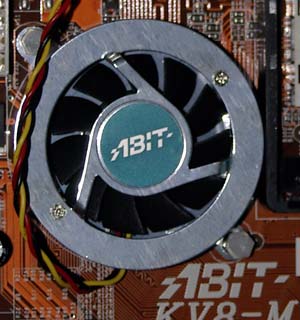
The VIA K8T800 is a traditional Northbridge/Southbridge chipset. Active cooling is used on the Northbridge to keep the chipset cool. The 8237 Southbridge has much less to do with the memory controller on the Athlon64 chip, and does not provide any cooling. The Southbridge remained cool during benchmarking.
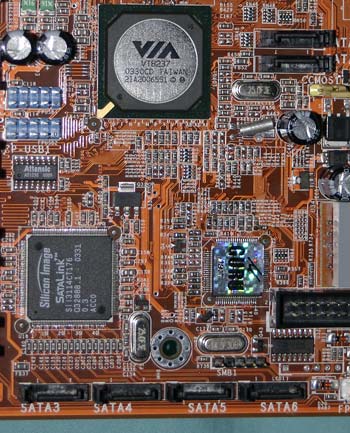
The KV8-MAX3 provides huge support for SATA drives with support for 2 drives by the VIA 8237 and an additional 4 SATA drives supported by the Silicon Image 3114 controller. Both controllers support SATA RAID in addition to regular SATA drive support. There are no on-board provisions for IDE RAID — a concession to market moves from IDE to SATA.
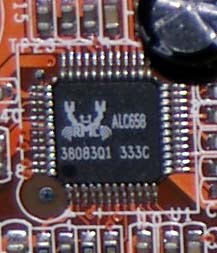
The KV8-MAX3 uses the newest and best version of the Realtek audio codec called ALC658. This audio chip features Dolby Digital 6-channel sound and UAJ or Universal Audio Jack. This allows automatic jack programming as we've seen on some boards based on Intel's 865/875 chipsets. Realtek markets the ALC658 as a premium sound solution, and their first 2.3 compliant audio codec. Realtek says:
The ALC658 has six 20-bit DAC channels, two pairs of stereo 18-bit ADC, and an AC'97 2.3 compatible six-channel audio CODEC designed for PC multimedia systems. The ALC658 incorporates proprietary converter technology to achieve 100dB sound quality, meeting performance requirements on PC99/2001 systems and placing PC sound quality at the same level as consumer equipment.More information on the features and specifications of ALC658 is available at Realtek.
If you have Dolby digital capabilities, SPDIF input and output is provided by optical jacks on the rear IO panel. Optical only SPDIF is provided — there are no jacks for coaxial SPDIF. The 5 rear panel mini jacks allow a full 4- to 6-powered speaker arrangement, while still leaving usable microphone and audio input capabilities. Many motherboards must program the rear-panel jacks and use the mic and input jacks for a 6-speaker setup. The ability to use six speakers, mic, and audio input is a nice feature.
In addition to the 4 USB 2.0 ports on the rear I/O panel, Abit provides an accessory bracket with two more USB 2.0 ports and 2 Firewire ports (one standard and one mini). Many users have front USB ports on their cases and the combo USB/firewire bracket may be their only added ports. It is nice to see the extra ports combined on one bracket to minimize the clutter caused by many individual brackets.
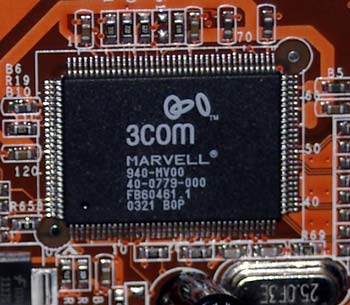
The KV8-MAX3 includes 3Com Gigabit LAN. As LAN connections have moved from added cards to an on-board feature, it appears that 3Com is now actively providing LAN chips to board manufacturers. It was not long ago that 3Com was only available as a premium add-in LAN card.
Abit has pioneered many of the overclocking options that we now take for granted. As a result, they were one of the first manufacturers to pay close attention to power regulation and grounding on their boards. We were, therefore, not surprised to see a 4-phase power design hidden beneath the OTES shroud on the MAX3. This should help provide stability for the board, which helps everyday operation as well as overclocking.
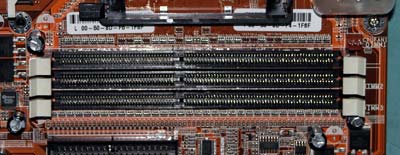
Three DIMM slots support standard unbuffered Single-Channel memory. Abit did not provide warnings or unusual DIMM-slot specs as we have seen on other Athlon64 boards. As we have already demonstrated in our launch articles on the Athlon64 and Athlon64FX processors, Dual-Channel memory provides only a small benefit on the A64 platform. The real memory performance difference between single and dual-channel is small and not comparable to the large performance differences that we see on the bandwidth-hungry Pentium 4. 1, 2 or 3 DIMMs can be installed to a maximum of 2GB.
Abit KV8-MAX3: Board Layout
In general the Abit KV8-MAX3 is arranged well, but there are several major problems with the current layout, namely the OTES cover, AGP/DIMM slots, and Floppy connector location.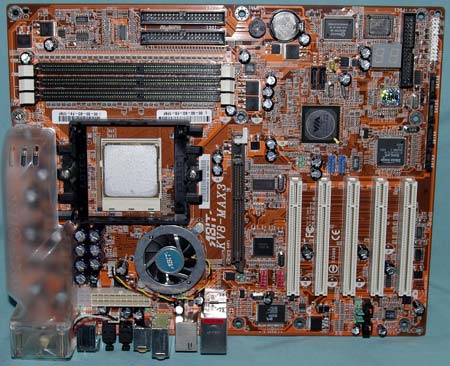
The KV8-Max3 is the dull red color that Abit seems to favor on their recent boards. It can be described as about the color of red brick. As you can see, the top-left of the board is occupied with the OTES power regulation and cooling solution.
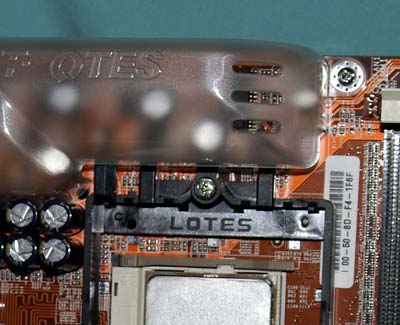
With OTES, a loaded board, and a 2-chip A64 chipset, there is not a lot of room to spare on the cleanly laid-out KV8-MAX3. This is annoyingly obvious when you get ready to mount the Athlon64 and CPU heatsink/fan. We could find no way at all to mount a standard A64 Heatsink/Fan without removing the OTES cooling shroud. If you will only mount a CPU once, this may not be that big of an issue, but the MAX3 is an enthusiast-level board, and will likely see more than one CPU over the life of the board. We can only recommend that you just use the standard board “Stand-Off” screws to hold OTES in place — or otherwise, a future CPU change may require complete removal of the motherboard. We hope Abit can fix this design problem quickly, or at the very least, provide clear instructions on removing the OTES shroud for CPU installation.
EDIT 11/08/2003 — Abit has informed us that the 2nd shipment of KV8-MAX3 motherboards have a revised OTES cover to allow easier mounting of the CPU. We are pleased to learn that Abit has corrected this problem.
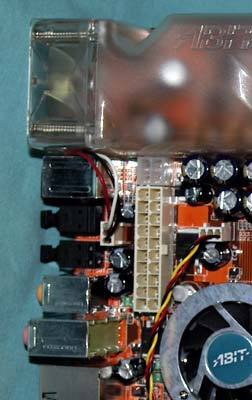
Unlike Athlon XP motherboards, the Athlon64 and FX51 boards that we have seen use a standardized ATX plus 12V connector arrangement. This is identical to the power connector requirements of current Pentium 4 systems. Generally, we prefer the connectors together on the upper right of the board, but Abit's placement of the 20-pin ATX and 4-pin 12V together at the upper left of the board is acceptable. The bulky ATX cable has to be routed over the OTES cover and the cable could, in rare cases, interfere with CPU cooling, but it is better than a mid-board placement. We would have preferred upper right for easiest cable routing.
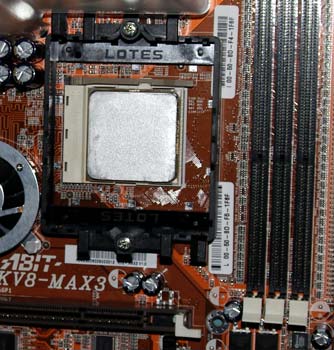
With OTES on the top and the northbridge fan on the left, the Athon64 754 socket is pretty tight on the KV8-MAX3. It appears that the large Zalman heatsink, or other large HSF, might have a problem mounting on this Abit.

The Primary/Secondary IDE connectors are all in our preferred position, above the midline of the board and to the right of the memory slots. This position on the top right edge of the board works well with cable arrangements in almost any case.
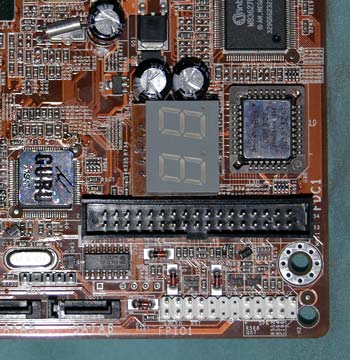
Unfortunately, the floppy connector is located on the lower right of the board. This will work fine in some case designs, but it will be a difficult reach in tower cases that might be used with this top-line board. It is also a location that makes neat cabling difficult in most cases. Manufacturers using the VIA chipset seem to be following the Reference board placement of the floppy connector, and there may be significant reasons why the floppy connector is placed low right. Whatever the reason, it is a poor location for the floppy connector.
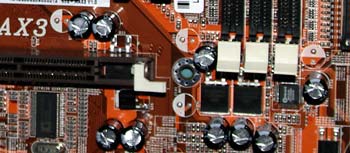
The KV8-MAX3 has only 5 PCI slots, but it places the 8X AGP 2 slots away from PCI 1. This is to allow for easy use of Abit 2-slot design video cards, and in general, is a good idea since most users leave the slot next to AGP open for cooling the video card anyway. However, Abit paid little attention to the placement of the DIMM slots in relation to the AGP. This is an Enthusiast board, and the targeted user will likely make many changes in memory. To do that, you really need to remove the video card because it is just too close to the DIMM slots to easily swap memory with an AGP card mounted. This is always a less than ideal arrangement, but it is particularly bad on an enthusiast board. Having to remove a top-line VGA card with extra power connectors just to change memory is a royal pain.
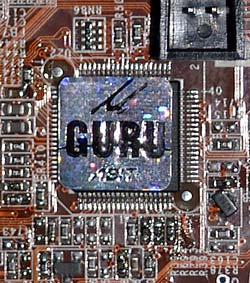
Abit uses their new µGuru chip on the KV8-MAX3.
Abit KV8-MAX3: µGuru
It seems that every email from Abit lately is talking about the virtues of their new µGuru chip. µGuru combines overclocking, PC Health/monitoring, Windows Flash utility, Audio controls and fan control into a single chip controlled by a Windows utility. While it is an interesting idea, and works well, it is quite similar to the CoreCell chip used by MSI, and the Windows-based control utility used by Gigabyte. The unique additions to µGuru are the Black Box module, which will record settings of all values for recall should the system crash, the ability of the overclocking module to save up to 3 overclock setups for instant recall, and the ability to return to the last known good overclocking setting.When the Abit KV8-MAX3 arrived, we tried out the µGuru utility and found almost all of the functions, including overclocking, disabled. However, several days later, Abit published a new version of µGuru and the new version functions as promised on the KV8-MAX3. Abit is excited about µGuru, and think enough of it to include a separate manual describing how µGuru works.
After installing the Windows utility, µGuru is accessed from a status bar icon by right-clicking. At the heart of the PC Health and Monitoring functions is Abit EQ, which can be customized to show whatever voltages, fan speeds, and other monitoring functions you choose to view.
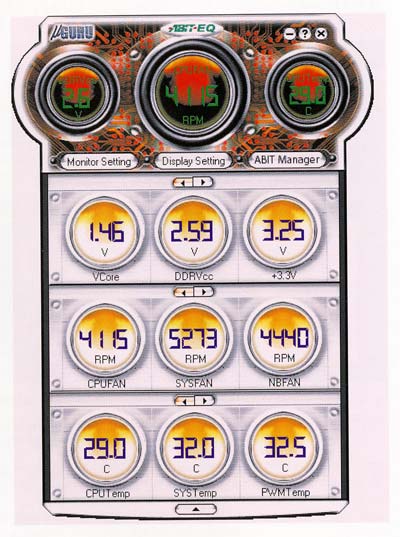
There are additional submenus that allow setting of temperature warning limits, and you can choose whatever custom display you want to satisfy your need for control of your system.
Abit Fan EQ is used to set up “Cool”, “Quiet”, “Normal”, and “User Defined” program lines to automatically control fans in the system.
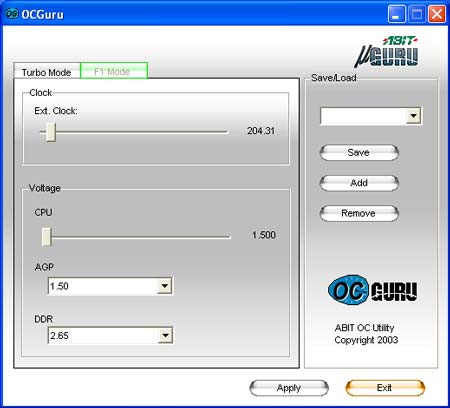
The Abit OC Guru is the heart of windows-based overclocking, and allows the tweaking of FSB, Multipliers, AGP Ratios, and Voltages while in Windows. This screen shot from the latest OC Guru on the KV8-MAX3 shows that there is still no means to adjust or fix AGP/PCI on the VIA chipset. This will be further discussed in BIOS and Overclocking. However, the other controls are there to allow FSB and voltage tweaking in Windows. While there is a Multiplier adjustment in the KV8-MAX3 BIOS, our Athlon64 chip was locked and it did not work. The Multiplier Factor does not appear in our OC Guru options, but it may appear if an unlocked Athlon64 was used.
To be perfectly frank, my first impression of µGuru was all Abit hype. However, after working with the latest µGuru for a while, it is a very impressive addition to Abit's boards. The control, monitoring, and overclocking functions are so extensive that they could probably even satisfy an obsessive/compulsive, but they are truly useful for getting at just the functions that you want to monitor and adjust. Abit has carried this idea further than the other incarnations that we have seen, and the results are impressive. Since this is a very early release, µGuru is likely to get even more useful as it evolves over time.
Abit KV8-MAX3: BIOS and Overclocking
NO AGP/PCI Lock, Added Multipliers
One of the ongoing issues with the VIA K8T800 chipset has been our criticism that it does not implement PCI/AGP lock. With Abit's history of catering to the Overclocking market, we believed that we would finally see an AGP/PCI fix on a top-line Abit board — if it would ever be seen on a VIA K8T800 chipset. Abit tells us that the PCI/AGP on the VIA do indeed float, and they have implemented additional multipliers to try to extend overclocking on the VIA chipset. Abit even goes so far as to report AGP/PCI frequencies in their SoftMenu readouts.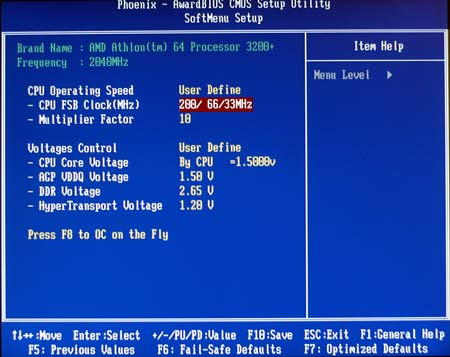
As you can see, at a FSB setting of 200, Abit reports the PCI/AGP at spec of 33/66.

At our highest stable overclock of 218, Abit shows AGP/PCI now running at 72/36. Our stock ATI card is known to have difficulties above about 72 to 74 on AGP, so this would support our belief that overclocking is being limited by the lack of an AGP/PCI lock.

By 230FSB, Abit reports AGP/PCI at 76/38.

Finally, at a 233FSB setting, the multiplier kicks in and we are back to 66/33 spec on the bus. The problem, of course, is that you have to reach 233 on overclock for the lower multiplier to kick in. We could not reach 233 with our Athlon64.
While we have seen it reported elsewhere on the web that VIA does fix PCI at 33 and allows AGP to float, we can find no evidence supporting that in the Abit BIOS. Frankly, we place more confidence in Abit's Engineers than we do on what is reported at other sites with no evidence. Based on what Abit tells us, we still have every reason to believe there is no AGP/PCI lock on the K8T800 chipset. This is also supported by the fact that we have never been able to overclock as far on a VIA board as we have achieved on an nForce3 chipset motherboard, which does implement AGP/PCI lock.
BIOS

Abit uses the familiar Award BIOS on the KV8-MAX3, and the latest incarnation of the familiar Abit SoftMenu overclocking utility. The available options should be very familiar to the computer enthusiast, who is the target audience for the KV8-MAX3, so we will not repeat the obvious.

Abit has supplied an incredibly complete selection of options in the PC Heath section of the BIOS. There are submenus for Temperature, Voltage, and Fan Speed monitoring, as well as a FanEQ Control section that gives full control of CPU, OTES, and NB fans.
FSB Overclocking Results
Abit prides themselves on their reputation as the “Overclocking” motherboard company. We, therefore, had high hopes that we would see new overclocking highs with our Athlon64.| Front Side Bus Overclocking Testbed | ||
| Default Voltage | Maximum Overclock | |
| Processor: | Athlon64 2.0GHz |
Athlon64 2.0GHz |
| CPU Voltage: | 1.5V (default) | 1.6V |
| Cooling: | AMD Stock Athlon64 Heatsink/Fan | AMD Stock Athlon64 Heatsink/Fan |
| Power Supply: | Enermax 465W | Enermax 465W |
| Maximum OC: | 2180MHz (+9%) 218FSB |
2180MHz (+9%) 218FSB |
The above overclocking setup at default voltage allowed us to reach a stable FSB of 218. As you can see, increasing voltage did not help at all, still topping out at 218. We suspect the issue here is that we have reached the highest AGP speed our 9800 PRO can handle, and that 218 has little to do with our CPU.
Unless Abit finds a way to implement half multipliers or AMD delivers Athlon64 processors that easily reach 233 on overclock or VIA decides they really do need to provide an AGP/PCI lock to compete with other chipsets, then the KV8-MAX3 is handicapped with the only current chipset without the ability to fix AGP/PCI. The VIA chipset, otherwise, is a joy to use and quite fast. However, after every manufacturer has promised an AGP/PCI lock on their VIA board and no one, not even Abit, has been able to deliver one that works, we are skeptical that we will see this major enthusiast issue corrected until VIA redesigns the K8T800 and their other chipsets – none of which have working PCI/AGP locks.
Abit KV8-MAX3: Stress Testing
We performed stress tests on the KV8-MAX3 in these areas and configurations:1. Chipset and motherboard stress testing, conducted by running the FSB at 218MHz.
2. Memory stress testing, conducted by running RAM at 400MHz with 2 DIMM slots filled and at 400MHz with all 3 DIMM slots filled at the lowest memory timings possible.
Front Side Bus Stress Test Results:
As normally done in our testing, we ran a full range of stress tests and benchmarks to ensure the Abit KV8-MAX3 was absolutely stable at each overclocked FSB speed. This included Prime95 torture tests, and the addition of other tasks — data compression, various DX8 and DX9 games, and apps like Word and Excel — while Prime95 was running in the background. Finally, we ran our benchmark suite, which includes ZD Winstone suite, Unreal Tournament 2003, SPECviewperf 7.0, and Gun Metal Benchmark 2. At default voltage, 218MHz was the highest overclock that we were able to achieve with the KV8-MAX3 while running these tests.Despite the fact that we could successfully run our standard tests at 218, the board was not as stable as we would like to see. At 216FSB, the performance was stable with whatever we threw at the KV8-MAX3. This is typical behavior that we used to see with an overclocked AGP/PCI bus, and we frankly had hoped those days were gone for good. For now, it looks like 8% to 9% is all the overclock that you will achieve with the VIA chipset and current Athlon64 processors. If you recall, we were able to run this same Athlon64 chip as high as 230FSB on Athlon64 boards with the nForce3 chipset. If this CPU could have reached just a bit further to 233, then we would have hit the multiplier that drops AGP/PCI back to 66/33.
Memory Stress Test Results:
This memory stress test is very basic, as it simply tests the ability of the KV8-MAX3 to operate at its officially supported memory frequency (400MHz DDR) at the lowest supported memory timings that our Mushkin PC3500 Level II Modules will support:| Stable DDR400 Timings — 2 DIMMs (2/3 DIMMs populated) |
|
| Clock Speed: | 200MHz |
| Timing Mode: | N/A |
| CAS Latency: | 2.0 |
| Bank Interleave: | N/A |
| RAS to CAS Delay: | 3T |
| RAS Precharge: | 6T |
| Precharge Delay: | 2T |
| Command Rate: | N/A |
We had no problem running 2 DS 512MB DIMMs of our standard Mushkin PC3500 Level2 in the KV8-MAX3. However, as we have seen in other VIA boards, we did have to relax RAS-to-CAS Delay to 3 for stable operation. At 2-2-3-6, operation was completely stable, but with slightly slower timings than the 2-2-2-6 that we have achieved in nForce3 Athlon64 boards.
Filling all available memory banks is more strenuous on the memory subsystem than testing 2 DIMMs, and in fact, we could not get 3 DS DIMMs to work in the Abit KV8-MAX3. We tried timings as slow as 2.5-3-3-6, but still could not get the Abit to boot. This makes us wonder if there may be more to the “side” limitations that some other boards have advised in their memory recommendations. We also tested with a DS module combined with 2 SS dimms, and still could not get the 3 dimms to work on the Abit. With support for 1GB DIMMs and a 2GB total memory limit, there may be limitations to filling slots on an Athlon64 board as we have seen on some earlier Intel chipsets. We plan to do further testing of the memory limitations of VIA and nForce3 chipsets in future testing of Athlon64 motherboards.
| Stable DDR400 Timings — 3 DIMMs (3/3 DIMMs populated) |
|
| Clock Speed: | 200MHz |
| Timing Mode: | N/A |
| CAS Latency: | N/ |
| Bank Interleave: | N/A |
| RAS to CAS Delay: | N/A |
| RAS Precharge: | N/A |
| Precharge Delay: | N/A |
| Command Rate: | N/A |
We tested the memory timings with 2 banks filled using several stress tests and general applications to guarantee stability. Prime95 torture tests were successfully run at the timings listed in the above charts. We also ran Sciencemark (memory tests only) and Super Pi. None of the three stress tests created any stability problems for the KV8-MAX3 at these memory timings.
Abit KV8-MAX3: Tech Support and RMA
For your reference, we will repost our support evaluation procedure here:The way our Tech Support evaluation works is first we anonymously email the manufacturer's tech support address(es), obviously not using our AnandTech mail server to avoid any sort of preferential treatment. Our emails (we can and will send more than one just to make sure we are not getting the staff on an “off” day) all contain fixable problems that we have had with our motherboard. We then give the manufacturer up to 72 business hours to respond and then we will report whether or not they responded within the time allotted, and if they were successful in fixing our problems. In case we don't receive a response before the review is published, any future responses will be added to the review, including the total time it took for the manufacturer to respond to our requests.
The idea here is to encourage manufacturers to improve their technical support as well as provide new criteria upon which to base your motherboard purchasing decisions. As motherboards become more similar every day, we have to help separate the boys from the men in as many ways as possible. As usual, we are interested in your feedback on this and other parts of our reviews, so please do email us with your comments.
You can access ABIT's RMA policy by going to their Taiwan web site first, at www.abit.com.tw. Click on the English (Americas) hyperlink and then click the eRMA (also known as Express RMA) hyperlink on the left-hand side of your screen (under the heading “support services”). Here, you will find an extensive description of Abit's RMA policy. Once you have finished reading Abit's policy, scroll down until you find a hyperlink reading www.abitusa-rma.com and click on it. Sift through the options until you reach three hyperlinks listing warranty info, RMA policy (again) and FAQ. Once you have read all the conditions, click on “I accept” and you will find a short RMA request form to fill out. Overall, ABIT makes finding and filling out RMA information quick and easy, not nearly as painstaking as other motherboard RMA procedures.
There are two main points that we'd like to reiterate about Abit's RMA policy:
1. ABIT, in contrast to other motherboard manufacturers, encourages the consumer to make direct contact with their RMA service instead of the predictable, “please get in touch with the vendor from whom you purchased the motherboard”.
2. Upon receiving a user's defective product in the terms the end user has set, ABIT will process the RMA and return the fixed product typically within the neighborhood of 10 business days.
For ABIT tech support information, end users should head on over to their U.S. website and click on the “support” hyperlink. This hyperlink will immediately take you to their primary tech support web page. ABIT clearly and concisely outlines several procedures for end users to follow before directly contacting ABIT tech support. You may view this page in its entirety by clicking here. ABIT also posts their e-mail address at the bottom of that tech support web page. Reaching ABIT by phone is fairly simple. Just ring them at the following number: 510-492-0968. ABIT holds excellent hours, ranging from 9:00 AM to 6:00 PM. Abit's phone hours are a bit better in the U.S., but other top tier motherboard makers like ASUS keep slightly better hours (of course, ASUS doesn't really answer their tech support phone calls, so it hardly matters).
As far as email tech support response time was concerned, ABIT did very well this time around, clocking in at 28 hours in answering our support email. We also telephoned another question and got immediate help with our issue. The telephone tech support was friendly and very helpful in general, and they answered our question with technical proficiency.
As stated in the past, Abit's RMA policy is unmatched in the U.S.; no other motherboard manufacturer comes close. In combination with their timely tech support reply, we feel ABIT is one of the best (if not the best) motherboard manufacturer to turn to for motherboard customer service and support in the U.S. We're glad ABIT continues to work hard on this aspect of their operations, and we sincerely hope to see similar steps taken at other top tier motherboard manufacturers in the future.
Performance Test Configuration
| Performance Test Configuration | |
| Processor(s): | AMD Athlon64 3200+ (2.0GHz) AMD Athlon64 FX51 (2.2GHz) AMD Athlon XP 3200+ (2.2GHz, 400MHz FSB) Intel Pentium 4 at 3.2GHz (800FSB) |
| RAM: | 2 x 512MB Mushkin PC3500 Level II 2 x 512MB Mushkin ECC Registered PC3200 2 x 256MB Corsair PC3200 TwinX LL (v1.1) |
| Hard Drive(s): | Maxtor 120GB 7200 RPM (8MB Buffer) Western Digital 120GB 7200 RPM (8MB Buffer) |
| Video AGP & IDE Bus Master Drivers: | VIA 4in1 Hyperion 4.49 (August 20, 2003) NVIDIA nForce version 2.45 (7/29/2003) NVIDIA nForce version 2.03 (1/30/03) |
| Video Card(s): | ATI Radeon 9800 PRO 128MB (AGP 8X) |
| Video Drivers: | ATI Catalyst 3.8 |
| Operating System(s): | Windows XP Professional SP1 |
| Motherboards: | Abit KV8-MAX3 @ 204.3FSB Gigabyte K8NNXP-940 Athlon64 FX51 Chaintech ZNF3-150 (nForce3) Athlon64 3200+ FIC K8-800T (VIA K8T800) Athlon64 3200+ MSI K8T Neo (VIA K8T800) Athlon64 3200+ nVidia Reference nForce3 Opteron144 @ 222.0 MHz FSB (2.0GHz) DFI NFII Ultra (nForce2 U400) Barton 3200+ Albatron KX18D PROII (nForce2 U400) Barton 3200+ Asus P4C800-E (Intel 875P) 3.2Ghz P4 |
Recent performance tests on Athlon64, nForce2 Ultra 400 and Intel 875/865 boards used 2 x 512MB Mushkin PC3500 Level II Double-bank memory. The Athlon64 FX requires Registered or Registered ECC memory, so tests with the Gigabyte K8NNXP-940 were performed with Mushkin High Performance Registered ECC DDR400 memory. Previous tests of motherboards used 2 x 256MB Corsair 3200LL Ver. 1.1. Mushkin PC3500 L2 was used to preserve the 2-2-2-6 timings that were used in tests with Corsair 3200LL Ver. 1.1. Both Mushkin and Corsair use the same Winbond BH5 memory chips in these modules.
All performance tests were run with the ATI 9800 PRO 128MB video card with AGP Aperture set to 128MB with Fast Write enabled. Resolution in all benchmarks is 1024x768x32.
For the fairest comparisons, benchmarks were recompiled for the Asus P4C800-E using a 3.2GHz Pentium4 processor.
Additions to Performance Tests
We have standardized on ZD Labs Multimedia Content Creation Winstone 2003 and ZD Labs Business Winstone 2002 for system benchmarking. Science Mark 2 Memory Performance, 9/23/03 update, was included to compare Memory Bandwidth and Latency of the Athlon64, Athlon64 FX51, and Pentium 4 3.2GHz.Game Benchmarks
We have added Gun Metal DirectX Benchmark 2 from Yeti Labs, the new X2 Benchmark, which includes Transform and Lighting effects, and Aquamark3 to our standard game benchmarks. We will be adding other benchmarks in the near future.Jedi Knight II has been dropped form our standard Benchmark Suite. We were forced to use different patches for operation on Athlon and Intel Pentium 4, which made cross-platform comparison difficult, if not impossible. In addition, Opteron/Athlon64 requires a third patching variation for benchmarking. JK2 uses a Quake engine, and we are continuing Quake3 as a standard benchmark for the time being.
Content Creation, General Usage and Memory Performance
Content Creation is a benchmark that has long been dominated by Intel's Pentium 4 processors. While the Abit KV8-Max3 did not quite perform at the level of the Athlon64 FX51, it is certainly competitive with P4 3.2GHz and compares well to other Athlon64 boards. Athlons normally outperform P4 on General Usage, but here, the Abit is an unusually strong performer, reaching FX51 performance levels.
Science Mark 2 was recently updated, and we used the latest 9/23/03 build for our Memory testing. The advantage of the on-CPU Memory Controller can clearly be seen in the very lowest latency levels for the Athlon64 compared to the FX51 and P4 3.2 processors. This very low latency is one of the reasons why the Athlon64 performs very well compared to Dual-Channel solutions. You can also see that while the FX51 has a very low latency compared to the P4, the latency overhead of Registered memory still increases latency compared to Athlon64 using regular unbuffered memory. Next year's Socket 939 should see a further drop in latency for the FX chip.
Media Encoding and Gaming Performance
The Gaming performance of the Abit KV8-MAX3 compares favorably to other Athlon64 and Athlon64 FX boards that we have tested, which is very good performance. While not quite the performance equal of A64FX, the Abit performs as well or better than any Athlon64 board that we have tested. The Athlon64 and Athlon64 FX dominate gaming benchmarks compared to other production processors.
High End Workstation Performance
As you can clearly see, the Abit KV8-MAX3 is very competitive in SPECviewperf benchmarks. Considering that it is running at an overclocked 204+ MHz at default, it looks comparable to other Athlon64 boards we have benchmarked. It, again, is not quite the equal of A64FX, but the real performance difference between the FX and the Abit A64 is small.
Final Words
The Abit KV8-MAX3 is a great addition to the MAX family, and certainly is worthy of the MAX name. It is brimming with features and provides just about every option you could want for tweaking an Athlon64 motherboard – except the ability to fix the AGP/PCI frequency to standard levels so that the board can achieve the highest overclocks. This, of course, is a VIA issue and not strictly a failing of the Abit KV8-MAX3. However, with MAX3 clearly aimed at the enthusiast and overclocker, the lack of AGP/PCI fix is not minor and must be considered a major fault. Abit has done an outstanding job in partially correcting the AGP/PCI lock problem by implementing additional multipliers that allow standard 66/33 AGP/PCI clocks at 233 and 266. Unfortunately, the Athlon64 processors we have tested do not quite reach that far, so the advantages of the new multipliers are lost on current chips. Future A64 processors will likely have more headroom — particularly once the .09 process is rolled out early next year.As a showcase for the new µGuru chip and utility, the Abit KV8-MAX3 is almost ideal. µGuru is not a truly new idea, since MSI and Gigabyte have similar products, but Abit's implementation is incredibly complete and full-featured. We fully expected µGuru to be ho-hum “seen-that, been-there”, but in fact, we were quite impressed with its robustness and true usefulness. On a better overclocking motherboard, µGuru will truly shine.
The board layout still needs work, particularly the impossibly tight CPU socket that requires removal of the OTES shroud to mount even the HSF that comes with Athlon64 retail packages. This may be as simple as a slight redesign of the OTES cover and the Northbridge fan, but we expect better than this from the company whose reputation is built on Enthusiast motherboards. Otherwise, the design is decent if not outstanding. The stability of the board, thanks to the careful attention to power regulation, is outstanding and up to Abit expectations.
In the end, the Abit KV8-MAX3 is one of the very best Athlon64 boards we have tested. However, its overclocking capabilities with the VIA chipset and current multipliers is pretty dismal. The nForce3-based Chaintech ZNF3-150 is a much better overclocker without the handicap of missing PCI/AGP locks. The base KV8-MAX3 performs about the same when the overclocked speed at default FSB is taken into account, but the Abit as it now stands is a mediocre overclocker. We're certain there will be improvements in the BIOS that will improve the overclocking capabilities, but there is more work to be done to find ways to bypass VIA's limitations created by the lack of an AGP/PCI lock.
There is much to like about the Abit. We have no problem recommending it as an excellent full-featured board with the wonderful µGuru chip to control everything about the board. However, if you are looking for an Enthusiast board for overclocking, this is not your board. Boards based on the nForce3 chipset perform about the same at stock speeds, but they are generally better at overclocking. It is true the nForce3-150 currently has limitations to HyperTransport speed, but we have found no real performance penalties resulting from this issue, which will be corrected soon with the nForce3-250 chipset. On the other hand, the performance penalties exerted by the inability to fix the PCI/AGP bus are real and limiting. It remains a complete mystery to us why VIA continues as the only chipsets without an AGP/PCI lock after all these months and years of losing market share. The K8T800 is as good as or better than nForce3 150, but this one feature will cause most enthusiasts to choose nF3 over VIA.
If Abit can find ways to add finer multipliers and/or develop a real AGP/PCI lock on the VIA chipset, then the KV8-MAX3 could evolve into the best, or one of the best, Athlon64 boards. But as it now stands, the Abit KV8-MAX3 is an outstanding, stable, wonderfully-featured board that falls short in overclocking abilities.







